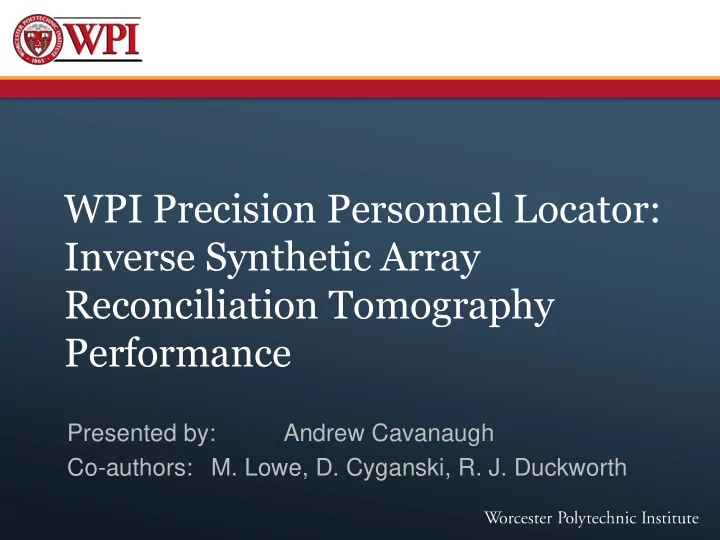

WPI Precision Personnel Locator: Inverse Synthetic Array Reconciliation Tomography Performance Presented by: Andrew Cavanaugh Co-authors: M. Lowe, D. Cyganski, R. J. Duckworth
Introduction 2
PPL Project Goals • To locate first responders indoors • With sub-meter 3D accuracy • Requiring no preinstalled infrastructure Rapidly deployable Ad-hoc mode 3
ISART Concept • ISART Exploits the Inertial Navigation strengths of both • Error growth with time RF and inertial • Requires frame of reference based navigation initialization (tedious) • Agnostic of RF conditions systems ISART RF Navigation • Uses inertial data over short • No error growth with time time intervals to form • Provides a static frame of synthetic aperture reference • Fuses RF samples at the • Hampered by multipath signal level 4
ISART Validation • We will be comparing the accuracy of the ISART algorithm to an RF-only algorithm ( σ ART) on the same data set • We will also show INS-only results • The INS processing for both the INS-only cases and the ISART cases are based on the same INS filter: OpenShoe project, www.openshoe.org [1] [1] Nilsson J.-O., Skok I., Handel P., Haris K. V. S., "Foot-mounted INS for Everybody An Open- source Embedded Implementation" in IEEE/ION Position Location and Navigation Symposium (PLANS) Conference, April 2012. 5
ISART Theory 6
ISART System 7
σ ART Signal Structure • Developed by WPI PPL project in 2006 [2] • Multicarrier Wide Band (MCWB) signal (1) • Asynchronous mobile unit (Transmitter) • Operates on entire set of received signals Spectrum analyzer capture of MCWB 𝑛−1 signal X(ω) = δ ( 𝜕 − (ω o+n Δω )) (1) 550-700 MHz. 100 carriers 𝑜=0 [2] Duckworth, J., Cyganski , D., et al. “WPI precision personnel locator system: Evaluation by first responders. 8 In Proceedings of ION GNSS, 2007.
σ ART: Hardware Artifacts The asynchronous transmitter introduces: An unknown time offset: τ An unknown mixer phase: θ When we take these parameters into consideration (1) becomes: 𝑛−1 (2) 𝑓 −𝑘(𝜕𝜐−𝜄) X′(ω)= δ ( 𝜕 − (ωo +n Δω )) 𝑜=0 The received signal on the 𝑞th antenna is therefore: (3) 𝑆 𝑞 (ω)=X(ω)𝐼 𝑞 (𝜕)𝑓 −𝑘(𝜕τ−θ) Which can be represented by a complex vector of DFT coefficients: 𝒔 𝑞 9
σ ART Algorithm The received signals, 𝒔 𝑞 , are stored in a • received data matrix, 𝑺 ∈ ℂ 𝑂×𝑄 , where N is the number of carriers and P is the number of reference antennas The inputs to the σART algorithm are: • • The received data matrix, 𝑺 • A point in space, (𝑦, 𝑧, 𝑨) • The locations of the 𝑞 reference antennas From this information a metric is computed • at every point in a discretized search space 10
σ ART: Re-phasing – For each point in the scan grid compute the distance to each of the reference antennas – Apply Example of re-phasing at a point near propagation the truth location delays to 𝑺 𝑺 → 𝑺’ 11
σ ART: Re-phasing # # # # 𝑺 ′ = 𝒔 1 𝑓 𝑘𝜕 𝑢 𝑙,1 𝒔2𝑓 𝑘𝜕 𝑢 𝑙,2 𝒔3𝑓 𝑘𝜕 𝑢 𝑙,3 𝒔4𝑓 𝑘𝜕 𝑢 𝑙,4 (4) Y position [m] Carriers X position [m] 𝑙 𝑢ℎ Scan Location: Actual Location: Reference Antenna: 12
σ ART: Metric Function 13
ISART System 14
INS EKF In order to correct for sensor drift, most INS • EKFs make use of zero velocity updates (zupts) If the inertial sensor is known to be • stationary, then a high quality observation of the velocity states can be used to correct the position and acceleration states Mounting inertial measurement units (IMUs) • on the foot allows for frequent zupts 15
ISART System 16
SAR Rephasing Inertial displacement estimates are used • to rephase RF data from multiple locations so that their direct path signals should appear to originate at the same locations The direct path components should be • linearly dependent The multipath components from multiple • locations should be uncorrelated 17
ISART: Array Synthesis • RF data from multiple transmitter positions are fused • Virtual antennas (determined from inertial displacements) represent additional data 18
Experimental Results 19
Auditorium Test • Most basic test configuration – 4 Reference antennas – Indoor line of sight – Small search area • Analog Devices ADIS16133BMLZ IMU • Walking prescribed path with foot zupts occurring on truth points 20
Test Configuration 21
σ ART (RF-Only): 2.30 m RMS error 22
Inertial-Only Results 23
ISART: 0.58 m RMS error 24
Wooden House Test • More complicated scenario – 16 Reference antennas (outdoor) – Indoor transmitter, no line of sight – Medium sized search area Intersense NavChip IMU • Walking prescribed path • with foot zupts occurring on truth points (no acute angles) 25
Test Configuration 26
σ ART (RF-Only): 2.20 m RMS error 27
Inertial-Only Results 28
ISART: 0.77 m RMS error 29
Lab Test • More complicated scenario – 16 Reference antennas – Indoor transmitter, no line of sight – Largest search area – Extreme multipath / blocked direct path • Intersense NavChip IMU • Walking natural path with truth points post- surveyed at footfall locations 30
Test Configuration 31
σ ART (RF-Only): 2.82 m RMS error 32
Inertial-Only Results 33
ISART: 1.77 m RMS error 34
Conclusions Created new framework for RF-INS sensor • fusion Performed multiple experiments to validate • this new approach Differs significantly from other fusion • techniques • Fuses RF data at signal level Leverages array processing gains • ISART shows improved performance over the • RF-only σ ART algorithm 35
Next Steps • TOA like synchronization could improve performance in presence of large reflectors • Real time implementation needed Fortunately ISART is highly parallelizable • 36
Thank You Questions? 37
Recommend
More recommend